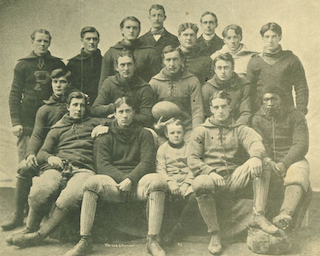
A portrait of the 1896 Iowa Hawkeye football team, the university’s first-ever conference championship football team, includes Frank “Kinney” Holbrook, the university’s first Black football player (first row, far right). Photo courtesy of the University of Iowa Archive, Department of Special Collections, UI Libraries
Nov/Dec 2023 (Volume 15, Issue 6)
By Quinn Early
In 1983, I accepted an athletic scholarship to be a two-sport athlete at the University of Iowa, where I played football, and participated in track and field. It was an amazing experience.
While at Iowa, I lived in Slater Hall but had no idea who Duke Slater was. I didn’t know about the history of those athletes that came before me, the ones who paved the way for the rest of us. There are many examples of incredible student-athletes who called themselves Hawkeyes. One such pioneer was Frank “Kinney” Holbrook.
I first learned of Holbrook when I was talking to a movie producer in 2019 about being involved in the production of a movie about Nile Kinnick. That conversation led me to doing some research. I stumbled upon a photograph of the 1895 Iowa Hawkeyes. In that picture was a young Black man called Kinney Holbrook (he was nicknamed “Kinney” by his Iowa teammates). Seeing that picture made me want to know more. What I found was simply amazing.
The life and times of Frank “Kinney” Holbrook is one of the most amazing stories that you have probably never heard. Born in 1877, Holbrook was the son of James Holbrook, who was born a slave in Georgia in 1851. As a boy, James Holbrook would be bought and sold on more than one occasion. When he was 11, he was purchased for $1,100 and taken to Virginia. At the age of 12, James Holbrook ran away from his captors and into the safety of the Union Army, where he met Capt. Lloyd Dillion. James Holbrook would serve as a valet for Dillon until the end of the American Civil War in April 1865.
After the war, James Holbrook accompanied Dillon back to his hometown of Iowa City. James Holbrook lived and worked in Iowa City and remained close with Dillon until he moved to the nearby town of Tipton. This is where he met Pinkey Wait, who was a native of Kentucky.
On July 2, 1874, after a brief courtship, the two married and later had two sons: Haywood Holbrook, who died at a very young age, and Frank “Kinney” Holbrook.
The town of Tipton was very progressive for that time. In fact, just a few hundred yards from the Holbrook property was a home that had been part of the underground railroad years earlier. The Holbrooks were not only accepted by the people of Tipton, they were entrenched in the community. James Holbrook performed odd jobs, doing home repairs, painting and facilitating the construction needs for the people of the town.
The fact that James was born a slave, had no formal education, and metaphorically had one hand tied behind his back because of his race never stopped him from being successful. He found a way to rise above it all. He was hard-working, trustworthy and had an impeccable reputation within the community. In fact, the people of Tipton relied on James Holbrook to repair and keep their homes and businesses running smoothly. With Pinkey by his side, James Holbrook was a successful businessman who bought a home and raised a family for four decades until his death on Nov 8, 1910.
Not only was James Holbrook a husband and hard-working businessman, he was also a stellar role model for his son, both directly and indirectly. He had many words of wisdom and encouragement for him. But it was the work ethic and dedication in putting 100 percent effort into whatever he did that was ingrained in the young Holbrook, and that would propel him to success both in the classroom and on the athletic field.
TO READ THE ENTIRE STORY AND OTHER FASCINATING STORIES ABOUT IOWA HISTORY, subscribe to Iowa History Journal.
